

 | Computer Modeling in Engineering & Sciences |  |
DOI: 10.32604/cmes.2022.017824
ARTICLE
Modelling Design of Color Graphics Books Using Visual Vocabulary Based on Children’s Color Language Preferences
1Department of Fine Arts, National Taiwan Normal University, Taipei, Taiwan
2Department of Civil Engineering, Shanghai Normal University, Shanghai, China
3Department of Exhibition Management, Macau University of Science and Technology, Taipa, Macau
*Corresponding Author: Wanni Xu. Email: 80760017t@ntnu.edu.tw
Received: 9 June 2021; Accepted: 6 August 2021
Abstract: Color language has important meaning for children’s picture books. Understanding children’s preferences in terms of color language will be helpful when designers model computerized picture books in order to adapt to children’s visual senses and effectively stimulate children’s interest in reading. In this study, we aimed to further explore the general characteristics of children’s preference for colors, color depth and color matching forms in picture books. For the study, 256 children between the ages of three and six were selected and divided into four groups. According to the implementation needs of the children’s color preference test, these children were asked to complete a series of tasks so that their choices in the tasks could subsequently be analyzed. The tasks included making the following choices: selecting their preferred colors from nine options (red, orange, yellow, green, cyan, blue, purple, black and white); selecting their preferred color brightness from three different color shades; and indicating their preferences in relation to complementary colors, matching colors and pure colors. The experimental results showed that children aged between three and six mainly favor red, blue and yellow, and colors with a high degree of brightness. As children grow older, boys tend to prefer blue, and girls tend to prefer pink, with red remaining the favorite color of both genders. As for complementary colors, matching colors and solid colors, three- to six-year-old children prefer solid colors. In conclusion, it seems that color language preferences in children between the ages of three and six are very similar, which could be of use when designing children’s picture books to match their visual vocabulary and psychological cognition.
Keywords: Modelling design; child psychology; color language; picture book design; visual vocabulary
Color is one of the most important forms of visual vocabulary. From the perspective of children, the visual impact of color determines children’s preferences and their level of interest. Color has a particularly significant influence on children in terms of visual vocabulary. Because of the limitations of children’s cognitive ability and psychological development, the status of color in early childhood education is more and more important. Starting from the design of children’s picture books, according to three- to six-year-old children’s sensitivity to color and their special preference for color, this paper discusses the objective fact that the color visually transmitted in children’s picture books can effectively attract children’s attention and enhance their interest in reading, and we explore how children’s picture book designs can be adapted to children’s visual taste and psychological cognition. Because of the value of picture book design for children’s reading and its high artistic and scientific quality, it meets the learning needs of children’s education. In any period is the perfect combination of design and art. The design of picture books that follow children’s physiological development is used to stimulate children’s visual vocabulary so as to stimulate their interest in reading. Thus, we expound the importance of rational application of color language in children’s picture books and its influence in the transmission of visual vocabulary.
Over the years, domestic and foreign scholars have done a great deal of research on human color hobbies in order to determine color preferences. The results are not consistent due to differences between countries, eras, cultural background and so on. An early study was performed by Chen [1], where he conducted research on pupils using various colors of the spectrum and showed that primary school students prefer side colors to central ones. In 1931, Wen [2] investigated primary school students’ color preferences and found that boys like white, black, cyan, red, green, orange, yellow and purple, respectively, while girls prefer black, white, cyan, yellow, red, purple, orange and green. His research showed that, at the time when the study was carried out, primary school students preferred non-bright colors and warm colors. In 1934, Chen et al. [3] used the dual comparison method to study students’ color preferences using color words. In 1965, Chen et al. [4] conducted research on preschool children, which showed the order of preschool children’s color preferences to be red, blue, green, then yellow. In 1995, Li [5] conducted research into the characteristics of children’s color preferences and concluded that children’s favorite colors are mainly red tones and the most luminous colors.
Color preferences in early childhood are not affected by experience, the color characteristics of objects, gender and age. In 2004, Liu [6] conducted a study on the color preferences of children between the ages of four and six, and the results showed a preference for red, yellow, orange, blue, purple and green. This study also reported that color preferences differed significantly between girls and boys, while there were no significant differences between ages. In 2009, Yang et al. [7] conducted experiments on the color preferences of four- to six-year-old children, showing that the favorite colors of young children at the time of the study were colors in the red series. The researchers found that this color preference was influenced by children’s experience and the attribution of colors to suitable objects. They also found that children aged between five and six differed significantly from other children in gender. There are various algorithms and computational frameworks [8–11] that exist to facilitate design and modelling of the color graphics books based on children’s color language. These can help to improve the color configuration of the graphics in the book.
Based on the results of previous studies, the purpose of this study was to further explore basic tendencies in relation to the following: the color preferences of children aged between three and six; preference for color depth; preference for the black, white and gray colorless system; and differences in preference for various forms of color matching. On the basis of repeating previous experiments, we hoped to explore not only children’s color preferences but also their preference for color depth, colorless black, white and gray, and color matching French style [12–16]. As a result, we concluded that knowing the color language that children find more attractive will help designers to create picture books that particularly appeal to children’s color preferences.
2.1.1 The Method Used to Test Children’s Preferences
Each child was asked to answer all questions separately, and each question was placed on a round card in different colors [17–19]. The cards all had the same shape (a common circle) to prevent the children from being misled by the shape. When each question was in progress, the pictures were presented to each child in a random order, and each child was allowed to pick his or her favorite colors, color shades and color matching methods, etc. If participants chose two or more at the same time, the experimenter guided them to choose the one that they liked the best. The way in which various pictures were arranged was also randomly changed to avoid the arrangement position influencing children’s choices.
2.1.2 The Method Used to Experimental Data Processing
In our study of children’s color preferences, the Chi-square test was used to analyze the experimental data [18], to explore statistical differences and to study whether there were significant differences in color language preferences among different age groups and whether there were significant differences in color language preferences in terms of gender (the results of which could, in turn, be used as an effective basis for designers in the creation of picture books). The Chi-square test is a widely used hypothesis test method, which is used in statistical inferences based on classified data, including the Chi-square test for comparison of two rates or two constituent ratios, the Chi-square test for comparison of multiple rates or constituent ratios, and correlation analysis of classified data [20].
The Chi-square test was used in this experiment to calculate the deviation between the actual observed value and the theoretical inference value of children’s preferences in relation to color and color matching mode. The deviation degree between the actual observation value and the theoretical inference value determines the Chi-square value. The higher the Chi-square value, the greater the deviation degree; on the other hand, the lower the Chi-square value, the less deviation there is; if the two values are completely equal, the Chi-square value is 0, indicating that the theoretical value is completely consistent [21–23].
We used the Chi-square test as a commonly used hypothesis testing method based on Chi-square test statistic distribution. Its invalid hypothesis H0 is the difference between observed frequency and expected frequency. First of all, it is assumed that H0 is established, and based on this premise, the Chi-square test statistic value is calculated, which represents the degree of deviation between the observed value and the theoretical value. According to the Chi-square test distribution and the degree of freedom, we can determine the probability P of obtaining the current statistics and more extreme cases when the H0 hypothesis is established. If the P value is very small, it means that the deviation between the observed value and the theoretical value is too large, and the invalid hypothesis should be rejected, indicating that there is a significant difference between the comparative data; otherwise, the invalid hypothesis cannot be rejected, and it cannot be said that there is a difference between the actual situation and the theoretical hypothesis represented by the color preference test data.
Based on this idea, the commonly used Chi-square test statistic was obtained, which was first proposed by the British statistician Karl Pearson in 1900, also known as Pearson Chi-square, which is labeled as X2. Its computation is as follows:
where Ai is the horizontal observation frequency; Ei is the expected frequency of i level; n is the total frequency; and pi is the expected frequency of i level. The expected frequency Ei of the i level is equal to the total frequency npi and the expected probability pi. k of the level is the number of cells. When n is relatively large, X2 statistics approximately obey the Chi-square distribution of k-1 degree of freedom. The following children’s color preference research test data were statistically analyzed by this method, and the Chi-square value was used to observe children’s color and color matching preferences.
The objects for this research were 256 children between the ages of three and six. They were divided into four groups, with each group comprising children of the same age (32 girls and 32 boys).
This research was carried out by asking the 256 children aged between three and six to complete six tests, as below:
1. Color preference test
Children chose their favorite color from nine small, circular cards (colored red, orange, yellow, green, cyan, blue, purple, black or white) (Appendix A. Table A1).
2. Color depth preference test
This entailed selecting the color depth that was most popular among the children aged between three and six, based on red, blue and pink. The children chose their favorite color shades from circular cards in dark red, dark blue, red, blue, pink and light blue (Appendix A. Table A2).
3. Test of preference for primary colors
Black, white and gray cards were made, and the children chose their favorite color from the three presented (Appendix A. Table A3).
4. Complementary color matching and solid color preference test
Cards with complementary colors were made, along with a card with solid colors. The children chose between the two so that their initial reactions could be observed as a test of which color matching method attracted the children’s attention (Appendix A. Table A4).
5. Matching same color system and solid color preference test
A set of cards with the same color system was made, along with a set with solid colors, and the children chose between the two sets so that their initial reactions to the color matching method could be observed and which cards attracted the children’s attention (Appendix A. Table A4).
6. Complementary color matching, same color matching and solid color preference test
Cards were made for complementary color matching and same color matching, and cards were made with solid colors. The children chose from among the three, and their initial reactions were observed as a test of which color matching method was more attractive to them (Appendix A. Table A4).
In this study, the above-mentioned statistical methods involving the Chi-square test were used to analyze the data from the color preference tests. The obtained X2 value and P value were used to judge the relationship between the effect of age and gender on children’s color language preferences.
The total number of participants in each age group was 64, and the total number of subjects was 64
The data on children’s preference for red, orange, yellow, green, cyan, blue, purple, black, and white colors were calculated and analyzed, providing statistics on children’s preferred colors, as shown in Table 1.
The order of the color preferences of three- to six-year-old boys (from “like” to “dislike”) was as follows: blue, red, green, yellow, black, cyan, purple, orange and white. The boys in this age group preferred blue, but a large proportion also liked red. Their favorite colors were scattered. In addition to the overall favorite of blue, they also liked red, green and yellow. It can be seen from the table that boys were in a state form in terms of color preferences. The preferred colors for three- to six-year-old girls were white, black, cyan, orange, green, blue, purple, yellow and red, respectively. Girls of this age were found to have a special preference for red. The second favorite colors (yellow and purple), third (blue, green and orange) and least favorite colors (cyan, black and white) are shown in each gradient. Color preferences are relatively equal.

Table 1 shows that children aged between three and six all prefer red. Boys and girls have a commonly disliked color (their least favorite color), which is white. Girls like red the most, followed by yellow. Boys like blue the most, followed by red. There are significant differences in color preference among boys and girls aged between three and six years (X2 = 147.03, P < 0.05). Overall, red is liked the most (accounting for 29% of the total), followed by yellow and blue (accounting for 16% and 19% of the total, respectively).
It can be seen in Table 2 that children aged between three and six have significant differences in terms of color preferences. The X2 values are 56.938*, 26*, 60.875* and 38.938*; df = 8; and P values are all less than 0.05.

There was a significant difference in color preferences among three-year-old boys (X2 = 12.438*, P < 0.05). Of these boys, most liked red (25% of the total), and those who liked cyan and white numbered the least (accounting for 3.13%). There was a significant difference in color preferences among three-year-old girls (X2 = 60.25*, P < 0.05). Red was preferred by most (50% of the total), and blue and white were the least favorite colors (accounting for 0%). There were clear differences in color preferences among three-year-old children, and the difference was significant (X2 = 56.938*, P < 0.05). Overall, the most favorite color among children was found to be red, and the least favorite color was white.
Significant differences in color preferences were found between four-year-old boys and girls (P < 0.05). Four-year-old children liked red the most, followed by blue, but four-year-old boys preferred blue, and girls preferred red. Gender differences in color choices were found to gradually emerge with increasing age.
There were significant differences in color preferences between five-year-old boys and girls (P < 0.05). Boys preferred blue (accounting for 53.13%), while girls preferred red (accounting for 31.35%).
There were significant differences in color preferences between six-year-old boys and girls (P < 0.05). Girls liked red most (accounting for 40.63%), and boys in the choice of favorite colors, showing a state of relatively equal choice of colors. The favorite color for children aged three to six years was found to be red in general (although in the case of five-year-olds, this was blue).
According to the analysis, we found that there was a statistically significant difference in color language preferences among children aged three to six years old. Three-year-old, four-year-old and six-year-old children were all found to prefer red, while five-year-olds preferred blue to red, orange, yellow, green, cyan, blue, purple, black and white. In terms of color brightness preference, children like bright colors, and as they get older, girls gradually show a tendency to prefer pink.
Fig. 1 is a histogram of children’s color preferences between the ages of three and six. Their preference is for white, cyan, black, orange, green, purple, yellow, blue and red, respectively (from “dislike” to “like”).

Figure 1: Percentage chart of color preference selection for children aged three to six years old
3.2 Children’s Preference for Color Shades
Table 3 shows that children aged between three and six all prefer red. Boys and girls have a commonly disliked color (their least favorite color), which is white. Girls like red the most, followed by yellow. Boys like blue the most, followed by red. There are significant differences in color preference among boys and girls aged between three and six years (X2 = 147.03, P < 0.05). Overall, red is liked the most (accounting for 29% of the total), followed by yellow and blue (accounting for 16% and 19% of the total, respectively).
Shows that from the age of five, girls begin to show a tendency to prefer pink. Girls aged between three and six prefer pink (accounting for 42.97%).

Clear differences can be seen among children of various ages in terms of their preference for dark, bright and light colors (P < 0.05). Children aged between three and six years most like bright colors (accounting for 64.06%). Children of this age may not be able to name color shades accurately, but in general, boys and girls like bright colors (Table 4). Colors that are too dark or too light are not conducive to attracting children’s attention.

3.3 Children’s Preference for Three Primary Colors
From Table 5, significant differences can be seen between boys and girls in all age groups (three- to six-year-olds) in terms of preference for black, white and gray (P < 0.05). When the three colors were tested separately with children aged between three and six, it was found that children aged three and four preferred black, followed by white. Children aged five and six preferred white, followed by black.

Table 6 shows that boys aged between three and six prefer black (accounting for 45.31%). White comes next (accounting for 38.28%). Girls prefer white (accounting for 51.56%). Of the three colors, children aged between three and six were found to like white the most (accounting for 44.92%).

When faced with a choice of neutral colors (black, white and gray), three- to six-year-olds preferred black, and five- to six-year-olds preferred white; that is, the older they were, the more they liked bright and simple white (Fig. 2). Our experiments enabled us to analyze the significant differences in children’s color language preferences and gain an insight into the particularity of children’s visual language (which may, in turn, help designers create picture books in line with children’s visual tastes). These modelling designs of color graphics books using visual vocabulary based on children’s color language preference reflects children’s understanding of colors and the importance of picture books in children’s education. Carrying the connotation of the development of children’s picture books education, it needs our extensive attention [24–26].
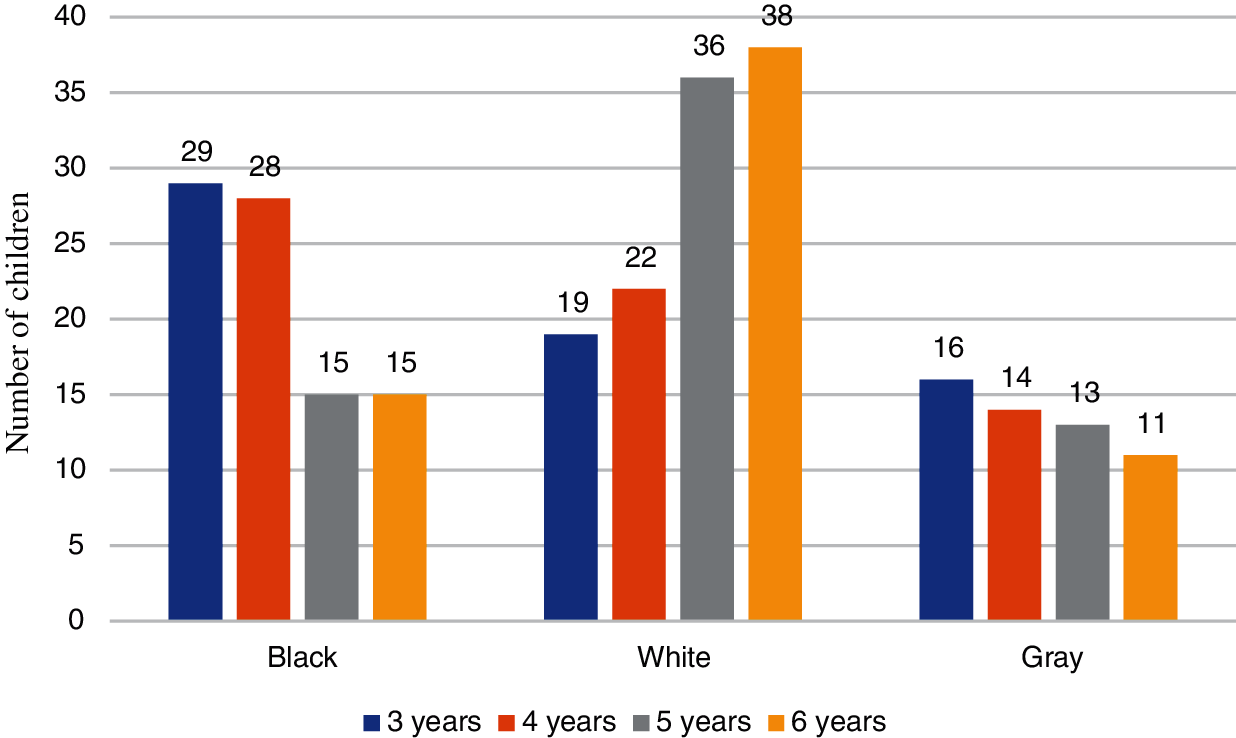
Figure 2: The number of children aged three to six years old who choose black, white and gray
3.4 Children’s Preference for Complementary Colors and Solid Colors
In Fig. 3, we can see that children aged three years prefer complementary color matching, compared to solid color, while children between the ages of four and six prefer solid color. It can be seen that younger children are more likely to receive color stimulation, and the strong contrast of colors presented by complementary color matching can arouse their interest more. Generally speaking, boys and girls aged between three and six prefer solid color matching. Simple, block-based color language is more popular with children.

Figure 3: The number of boys and girls aged three to six years old who choose the complementary color matching and solid color
3.5 Children’s Preference for Color Matching and Solid Color
We found a significant difference in preferences among children between the ages of three and six in terms of the same color combination and pure color (P < 0.05). They preferred solid color with a single color, rather than complex and varied combinations of the same color (Table 7). In other words, three- to six-year-old children like single, blocked color, and they do not like overly complicated color matching. Solid color is therefore also a highly acceptable way for children to match colors (as can be seen in Fig. 4).

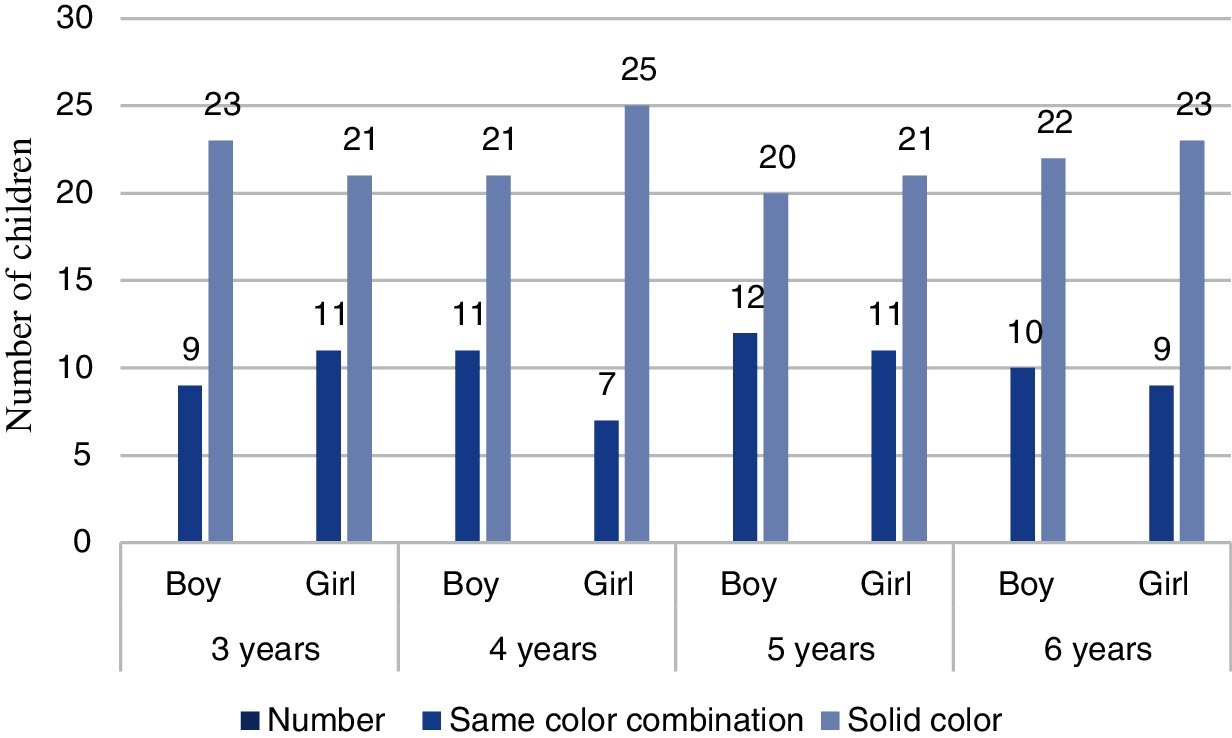
Figure 4: The number of boys and girls aged three to six years old who choose the same color combination and solid color
3.6 Children’s Preference for Complementary Color Matching, Same Color Matching and Pure Color
It can be seen from Fig. 5 that in terms of complementary color matching, preferences for same color matching and pure color appear at the same time. For children aged between three and six, pure color is still the most popular, followed by complementary color matching and finally, same color matching. We could conclude that children aged between three and six like single, blocky colors, and they do not like overly complicated color schemes. The visual effects presented by complementary color matching can stimulate the visual senses more, so it is also a more acceptable color matching method for children.
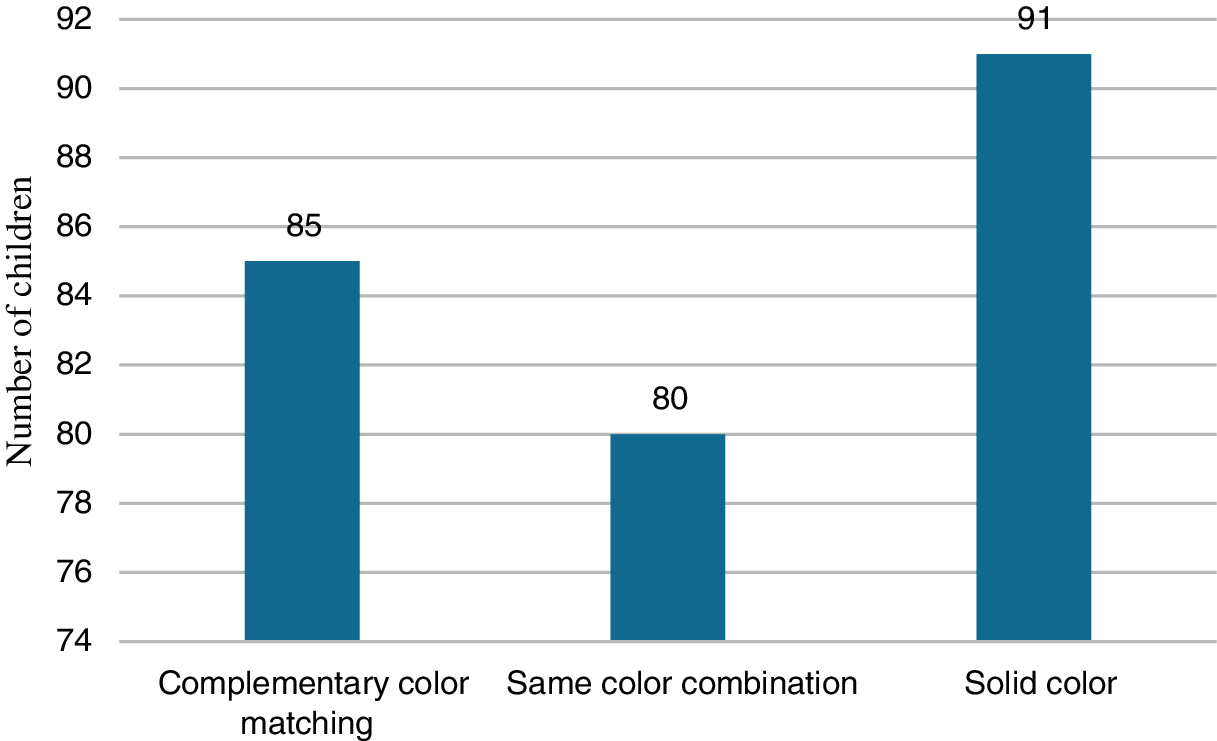
Figure 5: The number of three to six years old children choosing three kinds of color matching
The favorite color matching methods for boys between three and six were found to be complementary colors, solid colors and the same color. Girls’ favorite color matching methods were found to be pure color, complementary color matching and same color matching. Boys and girls liked different color matching methods, and they did not like the same color combination (Fig. 6).
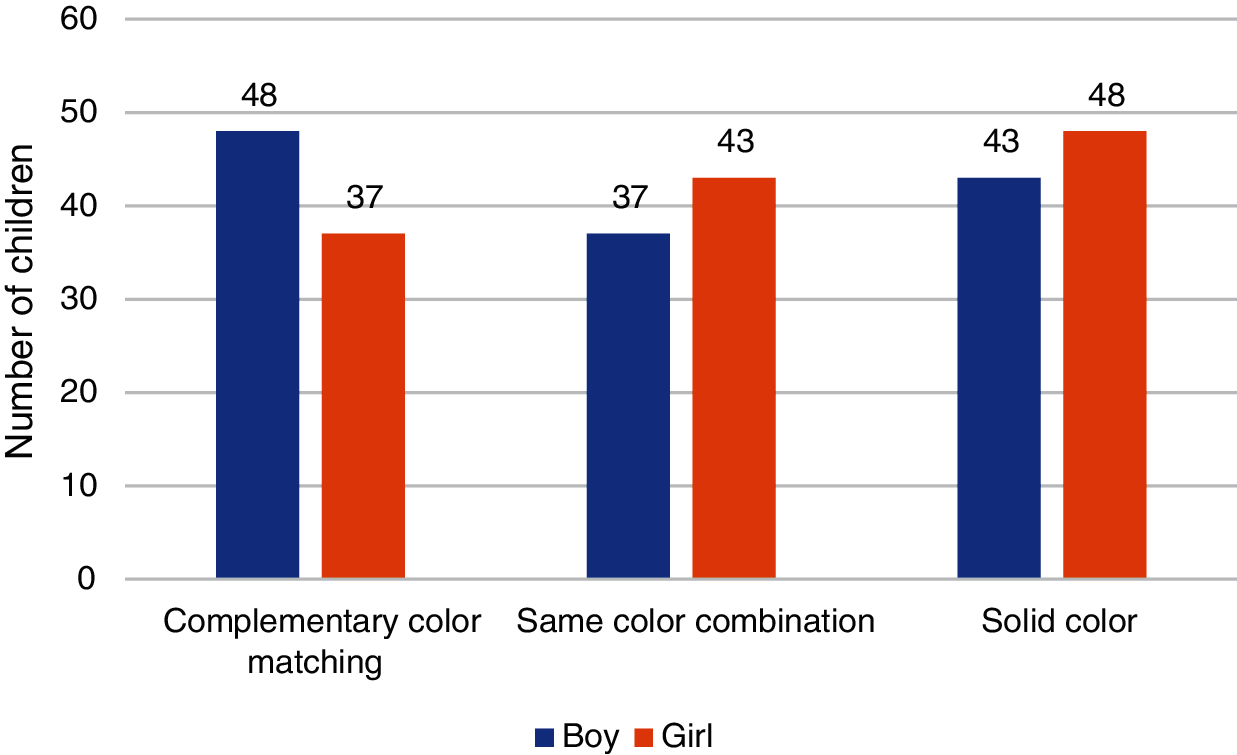
Figure 6: The number of three to six years old boys and girls choosing three kinds of color matching
4.1 Changes in the Order of Color Preferences
There are many factors influencing color language preferences, such as environment, education, region, age and so on. But generally speaking, the order of children’s color preferences does not change much, and the absolute position of red in children’s minds is unshakable. We found that when it comes to red, children between the ages of three and six show a great preference (29.3%). Other colors such as blue (18.75%) and yellow (15.63%) are also more attractive in children’s color vocabulary, especially among five-year-olds, who prefer blue to red. This finding is very different to the results of previous studies, and the popularity of blue has greatly increased among children. Red is still preferred by three- and six-year-old children, which further strengthens the absolute position of red in children’s color preferences; that is, red is still children’s favorite color.
When red, orange, yellow, green, cyan, blue, purple, black and white appear at the same time, black, cyan, orange and white are not very popular with children. We found that many children insist that they like other colors except red, such as black, cyan, white and so on, indicating that modern children have their own unique aesthetic power and are not easily influenced by others. The order in which children choose colors shows the degree of attractiveness of different colors to young children. This order does not have absolute meaning, only relative meaning.
As a form of artistic expression in children’s picture books, color language highlights the great effect of color on children’s visual transmission. Children have their own way of interpreting color language. This study shows that children aged between three and six prefer red, blue, yellow and other bright, contrasting, high-chroma colors, and they do not like dark and gloomy tones. Children this age will be resistant to black for psychological reasons. Children of this age have a limited range of color language preferences, so when picture books are designed, the use of color language needs to be more meticulous.
4.2 The Influence of Color in Visual Vocabulary
It can be seen from Table 2 that five- to six-year-old girls prefer pink to red but do not like light blue, which is similar to it. Boys between the ages of five and six prefer blue to red. This shows that children exhibit obvious gender differences in terms of color preferences as their age increases. Although five- to six-year-old girls were found to show a special preference for pink, children still showed an extreme preference for bright colors in dark, bright and light colors (64.06%). Dark colors were less popular with children (7.42%). Three- to six-year-old children prefer bright colors, strong contrast and a high level of color. They do not like dark and gloomy tones, and at this age, children will have a psychological resistance to dark colors.
If neutral colors-black, white and gray-are made available for children to choose from, they prefer white (44.92%), followed by black (33.98%). Three- to four-year-old children prefer black, and five- to six-year-olds prefer white. Children between the ages of three and four are more likely to be affected by visual stimuli and choose the first color printed into their eyes. Out of black, white and gray, children still prefer white.
4.3 Color Matching Preferences
Children prefer simple, block-like, solid colors, and children aged between three and six show highly similar preferences for the collocation of color language. Children between the ages of 3 and 6 are physically conditioned to be more attracted to colors than to physical objects. Because color can attract their attention to picture books, so as to increase their interest in reading. Therefore, it is very necessary for children’s picture book designers to design picture books in line with children’s visual vocabulary. Therefore, in the design of children’s picture books, especially design of the book cover, designers may want to choose the color matching method, presenting children with large areas of pure color blocks [27]. Due to the developmental limitations of children in this age group, they should not be presented with overly complex color schemes, which may distract their attention and hinder their thinking direction. Clever use of complementary colors and reasonable collocation of high-color colors can attract children’s attention and arouse interest. Children aged between three and six prefer high-color colors, but designers should avoid causing visual fatigue by excessive use of single colors [28–32].
Due to the influence of objective conditions such as experimenters’ experience, there may be some errors in our data. The subjects were three- to six-year-old kindergarten children, and inclusion of participants who are so young increases the difficulty of research. When children choose their favorite colors and color matching methods, there may be interference from various factors, which may lead to experimental errors. For example, the children might have just taken part in an art class and have color fatigue, or individuals might have just been criticized by the teacher and be feeling upset, resulting in them selecting a dark color [33–36].
Although the visual vocabulary of the children in our sample was stimulated by color for the purposes of our experiments, other factors might also have exerted an influence, such as family background, parental education and the children’s level of artistic development, etc., all of which might have had an impact on the children in our color tests [37]. Although this study cannot meet the color preferences of all children, it can be applied to the general preferences of children, which will make a great contribution to the design of children’s picture book designers.
4.5 Practical Application of the Research Results
This project (commissioned by the Ministry of Education of Taiwan) was carried out in 2020, with the aim of exploring the design of children’s English picture books. The design of the picture book was based on the experimental research data, and children love the result. As shown in Fig. 7, the background of the cover is white, which is highly preferred by children, and as much white space as possible has been used to avoid disturbing children’s vision. The main tone used on the cover of the picture book is blue, to provide some variation. The protagonist’s clothes are mainly red and yellow, and the character design is based on a five-year-old girl, as a template, to make it more relatable [38–41]. Since its publication in 2021, this textbook has achieved a good response, and children love it. Thus, it can be seen that children’s picture book designs need to adapt to children’s visual preferences in terms of color as much as possible. When children are attracted to the cover of a picture book in the first place, this will increase their interest in reading it.
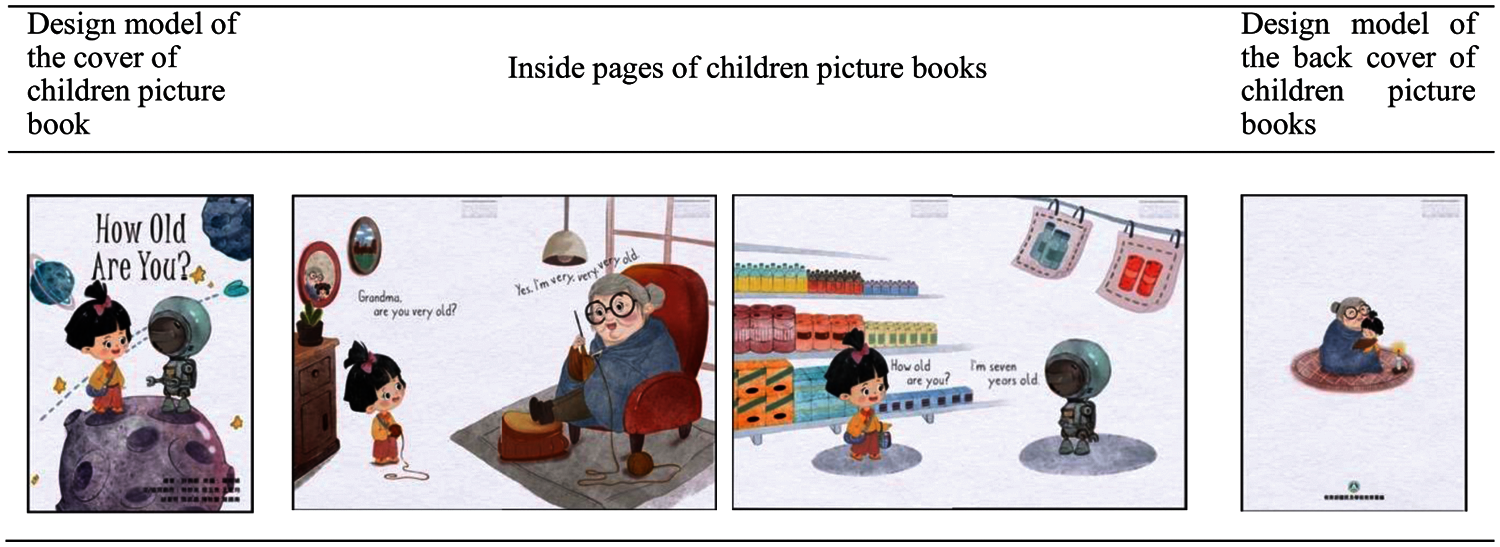
Figure 7: Children picture book pictures modelling designed by the author
Children’s experiences of reading have a great impact on them, and because of the limitations of children’s cognitive ability and psychological development, picture books play an important role in early childhood education. In January 2021, we were entrusted with revising the original version of this English textbook. In order to improve the efficiency of children’s education, we mainly started with color element design and layout planning to optimize the picture book.
In Fig. 8, we changed the color of the original volume from green to red, and the background color was lightened on the basis of red so that children could automatically distinguish between primary and secondary content when reading and learning. We changed the original monotonous black-and-white pattern to a more appropriate color to make the picture more interesting, without affecting the text. For example, in the catalogue column, we used solid color blocks to distinguish, making it easier to read for children with dyslexia.
In Fig. 9, we replaced purple, which is too dark, with blue. In the color language preference test, children showed a great love for blue. In the design of picture book teaching materials, under the premise of maintaining coordinated color matching, considering that most readers are likely to be in the range of three- to six-year-olds, we need to take into account children’s ability to extract information, and consciously use color blocks to distinguish the importance of information.
This set of picture textbooks for children is designed by using the experimental results of this paper. After design of the new version was completed, we conducted a simulation test on young children, and the results showed that children are more receptive to the new version of this illustrated textbook. This new edition of the book has already been published and is currently in print. The combination of the research results and picture book design not only reduces the difficulty of design for children’s picture book designers, but also improves children’s reading efficiency to a certain extent.
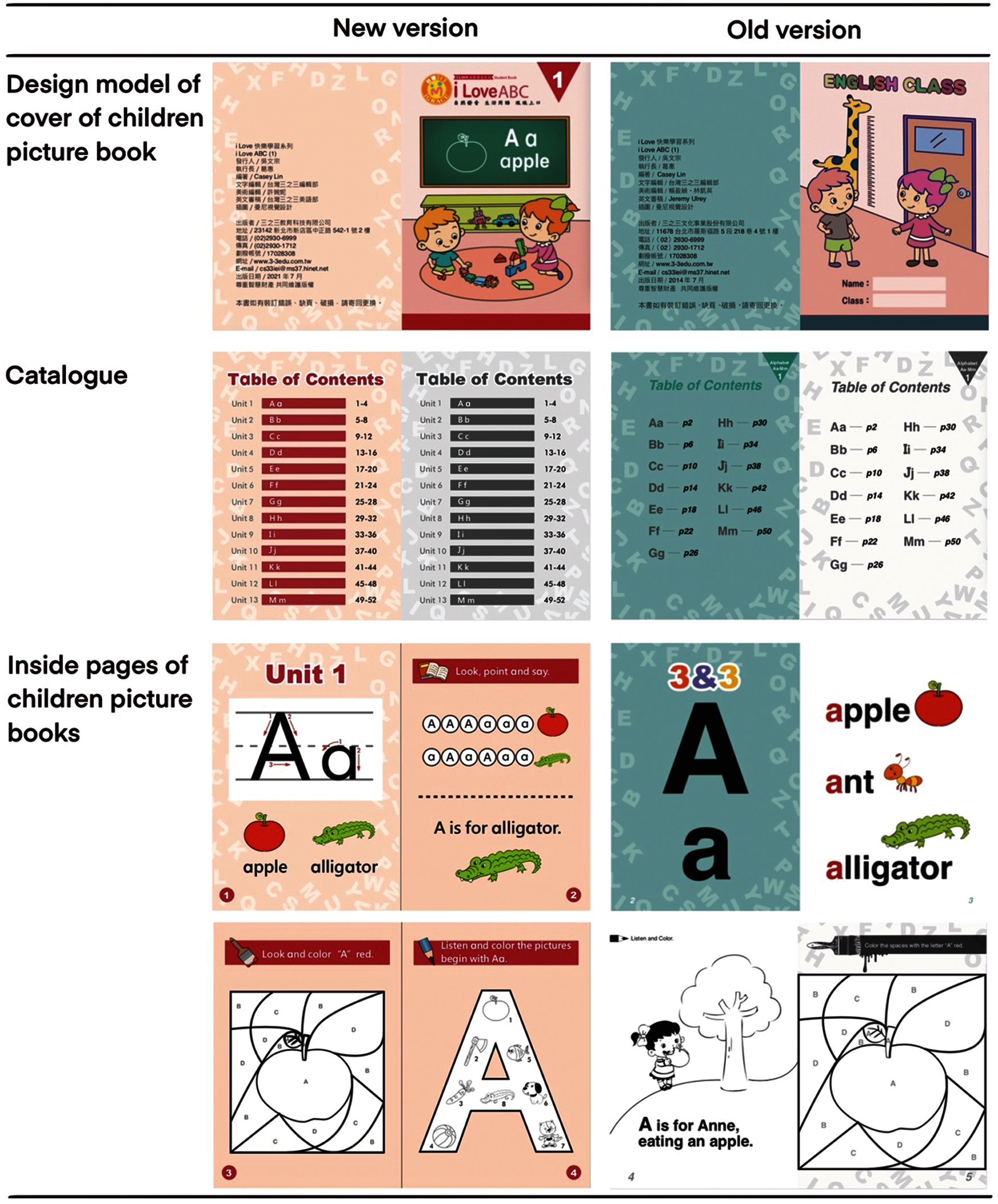
Figure 8: A comparison between the new and old versions of the first volume of children picture books
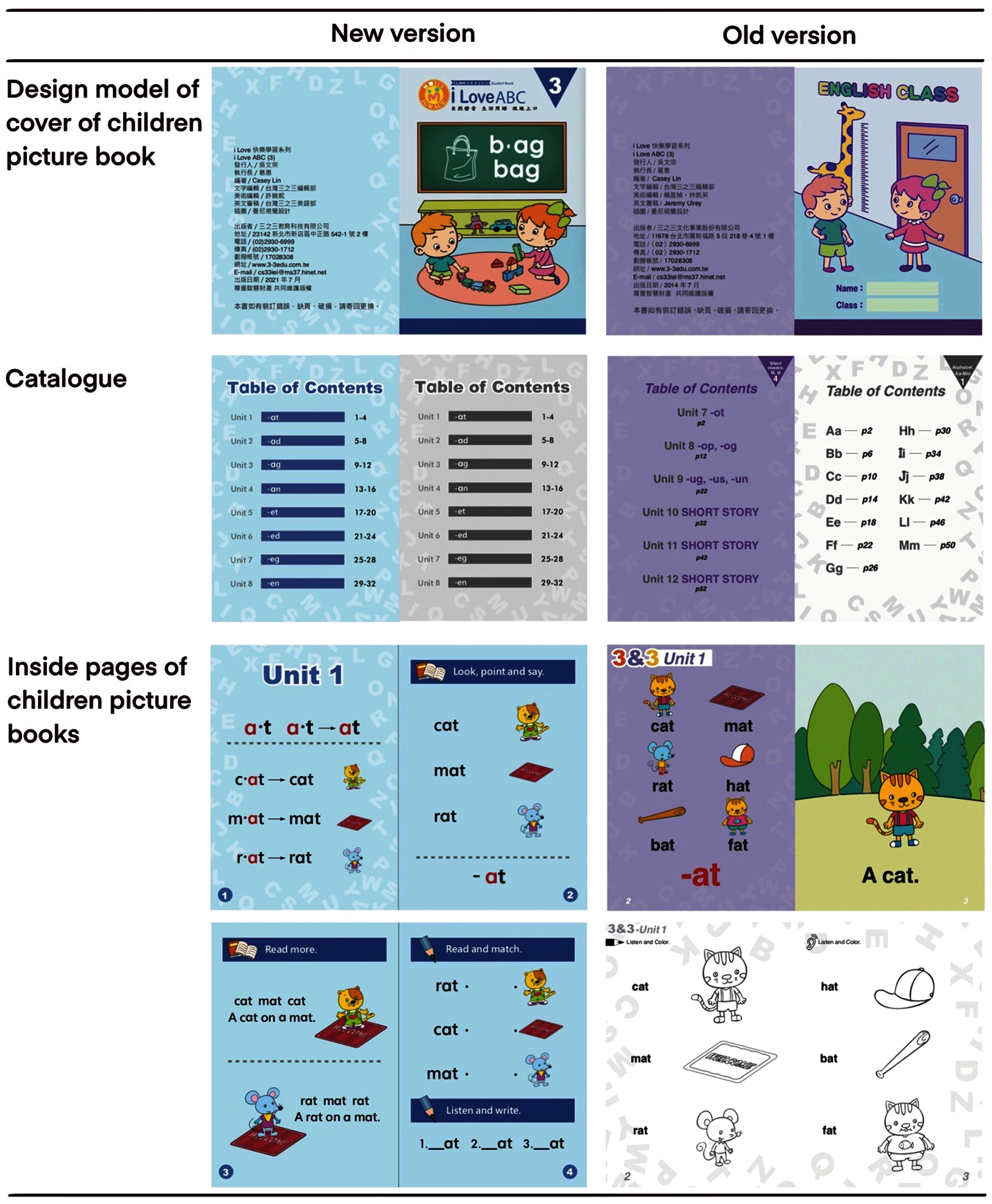
Figure 9: A comparison between the old and new editions of the third volume of children picture books
This study shows that the order of three- to six-year-olds’ general color preferences (from “like” to “dislike”) is red, blue, yellow, purple, green, orange, black, cyan and white. The most popular color in this age group was found to be red, and the average preference for red was significantly different to that for blue and yellow (P < 0.01). There were significant differences in color preferences between boys and girls. Three- to six-year-old boys preferred blue, red, green and yellow, while three- to six-year-old girls preferred red, yellow, purple and blue. The older children are, the greater the external interference factors are, and the greater the differences in color preferences between boys and girls.
For colors with different levels of brightness, three- and six-year-olds still prefer colors with high brightness and high color. Where the color is the same but there are different shades, children prefer bright colors to those that are too dark or too light. In addition to children’s favorite-red-we found that as children get older, boys show a preference for blue, and girls have a tendency to prefer pink. When making use of a light color system, according to the needs of different age groups, pink may be added, as appropriate, for girls.
Neutral color preferences were found to be white, black and gray, where the light and shade contrast effect is strong, which can attract the child’s attention. Therefore, book designs can be left relatively blank, which is not only in line with children’s preferences but also avoids having rather boring pictures, which may cause children to lose interest (although some designers or illustrators may be able to use black skillfully to convey “mysterious” content).
In the comparison of complementary color matching and solid color blocks, children were found to prefer solid colors, and in the comparison of same color matching and solid colors, children still liked solid colors. It can be seen that children are more inclined towards simple colors in color matching, and the use of solid color blocks can stimulate children’s interest. Therefore, in the design of healthy color vocabulary, the use of large areas of solid color blocks will boost appeal among children.
Children’s picture books are an important part of children’s literature. Many developments in society and culture put particular emphasis on art education, and this has gradually become an important aspect of children’s education. Young children are influenced on a psychological, physical and cognitive level, so color language in children’s picture books plays a key role. Children of all ages have different color preferences, and their visual acuity in terms of color discrimination should be used in a targeted manner in order to appeal to their visual aesthetic taste and stimulate their passion for learning.
Ethical Compliance: Here is no ethics approval required for this paper.
Funding Statement: The authors received no specific funding for this study.
Conflicts of Interest: The authors declare that they have no conflicts of interest to report regarding the present study.
1. Chen, H. Q. (1925). Research on child psychology, vol. 17, pp. 282–317. The Commercial Press. [Google Scholar]
2. Wen, Z. T. (1951). Color research, pp. 21–25. China: The Commercial Press. [Google Scholar]
3. Chow, S. K., Chen, H. P. (1935). General versus specific color preferences of Chinese students. The Journal of Social Psychology, (6), 290–314. DOI 10.1080/00224545.1935.9919740. [Google Scholar] [CrossRef]
4. Chen, L., Wang, A. S. (1965). Color and form preferences. Psychological Bulletin, (3), 83–87. DOI CNKI:SUN:XLXB.0.1965-03-011. [Google Scholar]
5. Li, W. F. (1995). Research on the characteristics of children’s color hobbies. Psychological Development and Education, (1), 9–14. [Google Scholar]
6. Liu, S. Y. (2004). An experimental study on the color preference of 4–6 year old children. Psychological Science, (3), 669–670. DOI 10.16719/j.cnki.1671-6981.2004.03.038. [Google Scholar] [CrossRef]
7. Yang, S. L., Zhang, L. (2009). Color preference of 4–6 year old children. Preschool Education Research, 11, 48–50. [Google Scholar]
8. Tang, Z., Zhao, G., Ouyang, T. (2021). Two-phase deep learning model for short-term wind direction forecasting. Renewable Energy, 173(72), 1005–1016. DOI 10.1016/j.renene.2021.04.041. [Google Scholar] [CrossRef]
9. Han, L., Zeng, B. (2014). Study on the characteristics of color preference in the paintings of children aged 4 to 6. Education and Teaching Research, 28(11), 123–125;129. DOI 10.13627/j.cnki.cdjy.2014.11.030. [Google Scholar] [CrossRef]
10. Xu, Z., Yan, D. (2015). Research progress on gender differences in color preference. Psychological Science, 38(2), 496–499. DOI 10.16719/j.cnki.1671-6981.2015.02.023. [Google Scholar] [CrossRef]
11. Zhang, T. Y., Zou, X. Y. (2016). Research on children’s color naming and preference, based on the survey of M kindergarten in Dalian. Early Childhood Education, (12), 25–29. [Google Scholar]
12. Zhao, H., Pang, W. G. (2017). Color preference of preschool children and its relationship with creativity. Basic Education, 14(1), 79–85. [Google Scholar]
13. Katz, S. E., Breed, F. S. (1922). The color preferences of children. Journal of Applied Psychology, 6(3), 255–266. DOI 10.1037/h0075274. [Google Scholar] [CrossRef]
14. Zhang, Z. H., Lin, Z. X., Sun, X. R. (1988). Experimental research on the same color matching, color naming and color hobbies of Uyghur children aged 2–6. Psychological Science Communications, 1, 41–44. [Google Scholar]
15. Li, W. F. (1990). Chinese metropolitan’s colour-loving characteristics–-relations between the loving colour and several kinds of factors. Psychological Science Communications, 5, 13–19. DOI 10.16719/j.cnki.1671-6981.1990.05.003. [Google Scholar] [CrossRef]
16. Huang, J. Y. (1991). Experimental study on the color hobbies of Dongxiang, Baoan, and Han children. Journal of Northwest Normal University (Social Edition), 2, 91–95. DOI 10.16783/j.cnki.nwnus.1991.02.023. [Google Scholar] [CrossRef]
17. Lin, Z. X., Zhang, Z. H., Sun, X. R. (1989). Discussion on color matching, color naming and color hobbies of Chinese children. Psychological Developments, 285(2), 62–65. [Google Scholar]
18. Lu, X. (1998). The basis of mathematical statistics, pp. 35–41. Beijing, China: Tsinghua University Press. [Google Scholar]
19. Liu, R. Q. (2007). SPSS statistical software, pp. 11–18. Beijing, China: China Press of Traditional Chinese Medicine. [Google Scholar]
20. Statistics Group of Institute of Mathematics in Chinese Academy of Sciences (1977). Analysis of variance, pp. 23–25. Science Press. [Google Scholar]
21. Jia, G. P., He, X. Q., Jin, Y. J. (2015). Statistics, pp. 36–49. China: China Renmin University Press. [Google Scholar]
22. Wei, L. S. (2018). Mathematical statistics, pp. 11–14. Science Press. [Google Scholar]
23. Zhao, B. J. (2019). Application of multivariate statistical analysis, pp. 52–56. China: China Renmin University Press. [Google Scholar]
24. Zeng, H. W. (1986). The characteristics and development of Chinese students’ color hobbies. Psychological Science Letters, (1), 18–24. DOI 10.16719/j.cnki.1671-6981.1986.01.004. [Google Scholar] [CrossRef]
25. Wolsobbin, Ri, D. J., Cheng, X. C. (1986). Preschool children’s choice of color under positive and negative emotional experiences. Psychological Development and Education, (4), 47–50. DOI CNKI:SUN:XLFZ.0.1986-04-008. [Google Scholar]
26. Witte, B. (1979). Psychological anthropology, pp. 345–364. Taipei: Liming Cultural Enterprise Co., Ltd. [Google Scholar]
27. Lu, M. Y., Zhao, J. (2018). A study on the application of color elements in children’s design. Popular Literature and Art, (2), 118–125. [Google Scholar]
28. Zhao, Z. B. (2015). A brief analysis of the color and layout design in children picture book. Art Magazine, 8, 123–137. DOI 10.3969/j.issn.1002-2953.2015. [Google Scholar] [CrossRef]
29. Zhang, L. (2006). Child developmental psychology, pp. 54–56. Wuhan, China: Central China Normal University Press. [Google Scholar]
30. Chen, S. S. (2017). The design expression of color elements in the design of children picture book. Art Education Research, (20), 57–63. [Google Scholar]
31. Chen, X. (2020). Research on visual design of picture book based on children’s color cognitive characteristics. Western Leather, 42(3), 72. [Google Scholar]
32. Oster, G. D. (2013). Using drawings in assessment and therapy (2). pp. 20–21. Nanjing, China: Southeast University Press. [Google Scholar]
33. Ai, M., Liu, Y. H., Qi, X. H., Lei, L., Chen, Y. S. et al. (2015). The effect of color on human physiology and psychology. Chinese Journal of Health Psychology, 23(2), 317–321. DOI 10.13342/j.cnki.cjhp.2015.02.042. [Google Scholar] [CrossRef]
34. Zhu, Z. X. (1996). Child psychology, pp. 31–35. Beijing, China: People’s Education Press. [Google Scholar]
35. Zhang, J. J. (2004). General psychology, pp. 53–62. Guangzhou, China: Guangdong Higher Education Press. [Google Scholar]
36. Liu, H. M., Zhang, J. J., Liu, L. H. (2005). Relationship between color terms and color cognition. Advances in Psychological Science, 13(1), 10–16. [Google Scholar]
37. Zhang, Y. L. (2015). Review and prospect of research on preschool children’s color cognition. Journal of Chengdu Normal University, 31(5), 25–30. [Google Scholar]
38. Brian, C. R., Goodenough, F. L. (1929). The relative potency of color and form perception at various ages. Journal of Experimental Psychology, 12(3), 197–213. DOI 10.1037/h0070967. [Google Scholar] [CrossRef]
39. Eysenck, A. J. (1941). A critical and experimental study of color preferences. American Journal of Psychology, 54(3), 385–394. DOI 10.2307/1417683. [Google Scholar] [CrossRef]
40. Miao, J. Q. (2020). Research on the design of children picture book. Industrial Design, (8), 50–51. DOI 10.3969/j.issn.1672-7053.2020.08.024. [Google Scholar] [CrossRef]
41. Golomb, C. (2008). The child’s creation of a pictorial world, pp. 31–34. Beijing: China Light Industry Press. [Google Scholar]
Appendix A.




 | This work is licensed under a Creative Commons Attribution 4.0 International License, which permits unrestricted use, distribution, and reproduction in any medium, provided the original work is properly cited. |